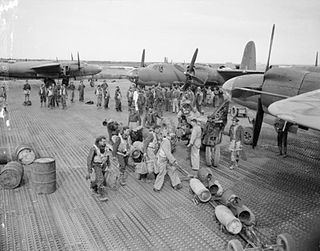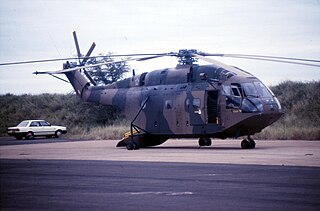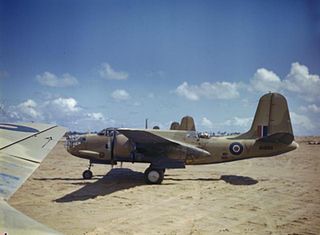
The Martin B-26 Marauder is an American twin-engined medium bomber that saw extensive service during World War II. The B-26 was built at two locations: Baltimore, Maryland, and Omaha, Nebraska, by the Glenn L. Martin Company.

2 Squadron is a squadron in the South African Air Force which was formed in 1940. The squadron has a long history, having been involved in every single combat action in which the SAAF has taken part. During the Second World War it made a name for itself in the battles for East Africa, before distinguishing itself in North Africa as part of the Desert Air Force, and later in Italy.

1 Squadron SAAF was an air force squadron of the South African Air Force and was formed at Air Force Station Swartkop in February 1920, equipped with De Havilland DH.9's part of the Imperial Gift donation to South Africa by Britain. On 31 August 1939 the squadron was re-designated as 1 Bomber/Fighter Squadron and this was then changed to 11 (Bomber) Squadron in December 1939. The squadron was resurrected in February 1940 by the renumbering of 6 Squadron, equipped with four Hurricane Mk 1's and six Furies.

No. 14 Squadron of the Royal Air Force currently operates the Beechcraft Shadow R1 in the Intelligence, surveillance, target acquisition, and reconnaissance (ISTAR) role from RAF Waddington.

Number 15 Squadron, sometimes written as No. XV Squadron, was a squadron of the Royal Air Force. It most recently operated the Panavia Tornado GR4 from RAF Lossiemouth as No. XV (Reserve) Squadron. It was the RAF's Operational Conversion Unit for the Tornado GR4 which taught pilots and Weapon Systems Officers (WSO) how to fly the aircraft and what tactics to use to best exploit the performance of their aircraft and its weapons.

40 Squadron SAAF existed as a combat unit from early 1940 through to late 1945. It served in the East African Campaign, Western Desert, Tunisia, and Italy, reaching Austria by the end of World War II. The squadron's motto in those years was Amethlo e Impi – "the eyes of the army".
No. 37 Squadron was a Royal Air Force squadron of the First and Second World Wars.

No. 223 Squadron RAF was a squadron of the Royal Air Force. Originally formed as part of the Royal Naval Air Service (RNAS), the Squadron flew in both World Wars.

3 Squadron SAAF was a squadron of the South African Air Force. It was formed in January 1939 at Air Force Base Waterkloof and was equipped with Hawker Hartbees I and Hurricane Mk II aircraft. The squadron was moved to Port Elizabeth in September 1939 after which it was disbanded. It was again reformed at Waterkloof on 9 September 1940 equipped with Hurricane Mk 1s.

4 Squadron SAAF was a South African Air Force unit which served during World War II.

5 Squadron SAAF was a South African Air Force Fighter / Fighter-Bomber squadron during World War II. It was disbanded at the end of the war and was re-commissioned in 1950. It remained active until 2 October 1992, when it was disbanded; its Atlas Cheetah E aircraft were also decommissioned.

12 Squadron was a South African Air Force squadron that served in the Second World War in East Africa and the Western Desert as a medium bomber squadron. After the war, the squadron was used in various roles, including that of a helicopter squadron until 1963, when it was equipped with English Electric Canberra light bombers, remaining a light bomber and reconnaissance squadron until disbanded in 1990.

10 Squadron was a squadron of the South African Air Force. It was formed as a fighter bomber unit on 1 April 1939 and was deployed in a coastal defence role as part of Coastal Command SAAF until 1943. It was disbanded after the threat of Japanese naval actions off the South African coast had waned. It was re-activated as a fighter squadron on 25 May 1944 and deployed to the Middle East where the squadron saw service in Syria, Libya and the Aegean and was disbanded at the end of the war in Italy.

11 Squadron was a World War II squadron of the South African Air Force. It was created in South Africa in 1939 and served in East Africa until 1941 as an army cooperation and reconnaissance squadron. It was re-formed in 1944 as a fighter bomber squadron and served in Italy until 1945 when it returned to Egypt and was disbanded on conclusion of the war on 30 October 1945. It was re-activated in 1974, flying Cessna 185s as an army liaison squadron until 1991 when it disbanded for the final time.

25 Squadron was a maritime patrol and later medium bomber squadron of the South African Air Force during World War II. It was re-constituted twice between 1951 and 1990 as a medium transport squadron and was finally disbanded in October 1990.

31 Squadron was initially a World War II Coastal bomber/reconnaissance squadron South African Air Force. It was later converted to a heavy bomber squadron that operated from bases in the Mediterranean from January 1944 until the end of the war. On conclusion of hostilities, the squadron was used to ferry liberated POW's from Italy back to Britain and disbanded South African troops from Italy to Egypt. It was disbanded on 15 December 1945. It was resurrected as a medium and light helicopter squadron in 1982 and operated from AFB Hoedspruit until its final disbandment on 4 December 1992.

30 Squadron SAAF was a squadron of the South African Air Force. It was established in 1944 and saw service as a medium bomber squadron in Italy during the Second World War. After the war, the squadron was disbanded and was resurrected in 1980 as a medium transport helicopter squadron – a role it retained until it was finally disbanded in 1991.
The History of the South African Air Force spans the First World War, Rand Rebellion of 1922, the Second World War, the Korean War, the South African Border War, and varied peacekeeping operations since 1994. Its battle honours include German South West Africa 1914–15, German East Africa 1915–1918, East Africa: 1939–1941, Middle East: 1941–43, Madagascar 1942, Italy 1943–1945, the Balkans 1943–1945, and Korea 1950–1953.

No. 3 (S.A.) Wing was a South African Air Force commanded formation during World War II that served in North Africa, Sicily and Italy. The formation was recommended by HQ RAF Middle East on 28 October 1941 to the Air Ministry and authorised by AIR54/96 on 3 November 1941. The Wing initially consisted of Royal Air Force and South African Air Force squadrons under South African command: No. 11 Squadron RAF and No. 113 Squadron RAF with Bristol Blenheim bombers and fighters and No. 12 Squadron SAAF, No. 21 Squadron SAAF (both with Martin Maryland bombers and No. 24 Squadron SAAF with Douglas Boston bombers. The latter unit was re-assigned to Army Cooperation before the start of Operation Crusader while No. 113 Squadron was assigned to Whitforce. This left 12, 21 Squadrons SAAF plus No. 11 Squadron RAF as its assigned units, with additional units being assigned later. Two RAF squadrons left for the Far East when Japan declared war in December 1941.

16 Squadron SAAF is an attack helicopter squadron of the South African Air Force (SAAF). It was originally formed in World War II as a maritime patrol squadron, however, over the course of the war it was disbanded and reformed a number of times, operating a number of different types of aircraft. It was finally disbanded in June 1945 and was not re-raised until 1968 as a helicopter squadron. In the late 1980s the squadron took part in the conflict in Angola before being disbanded again in 1990. It was raised once more in 1999 and it is currently operating the Rooivalk attack helicopter.
























